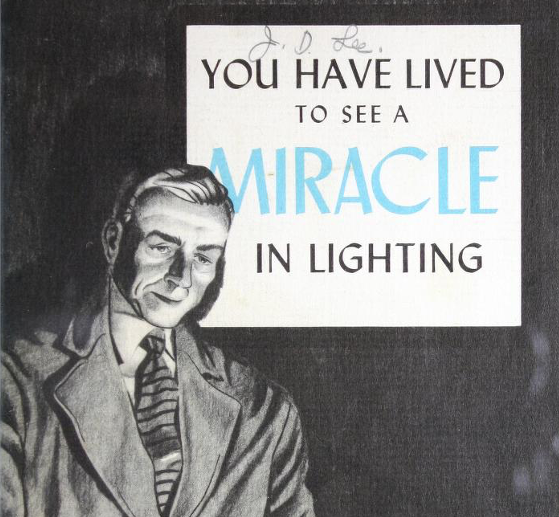
Mike Jackson
Lighting: A Catalog History
The Building Technology Heritage Library is a free, online research library of pre-1964 architectural trade catalogs, house plan books and builder’s technical guides.
The architectural evolution of lighting can traced through trade catalogs in the Building Technology Heritage Library (BTHL). The story starts with gas lighting fixtures of the 19 century and then moves to the great technological advance of electric lighting. There was a short time period when combination electric and gas lighting were used, as the public transitioned from one technology to another. The incandescent light bulb won this race and reigned supreme for more than 50 years until the introduction of fluorescent lighting in the 1930s.
The electric light bulb presented a new opportunity for designers, who shaped light fixtures in a wide variety of architectural motifs. The chandelier had its origins in candles and gas lighting and easily made the adaptation to electricity. Light fixtures could be fashioned to match the architectural motifs that were always changing – classical, colonial, art deco and modern are some of the common names found on light fixture catalogs, particularly those marketed for residential use. The electric light bulbs could do things that flames could not – such as recessed lighting and cove lighting and even underwater lights.
The era of fluorescent lighting began in the 1930s and quickly took over as the principle lighting system for the modern office and store. Later innovations include the integration of lighting into ceiling systems, a development that is still with us today. Neon lighting for signage and specialty applications was a special niche in the lighting story, which found widespread use from the 1930s to the 1970s. The neon sign was a ubiquitous part of the urban commercial landscape, but was ultimately replaced by other lighting technologies. The BTHL documents end with 1963 when copyright laws changed, so later 20 century lighting technologies are not included. The BTHL has more than 700 documents under the topic of “lighting,” with a wide rage of topics from airports to display windows.
This very early lighting publication presents the advantages of the incandescent light bulb over electric arc or gas lighting. Among these advantages are its safety, multitude of applications, and economy. Today we know that the incandescent light bulb was a truly revolution in lighting, one that is still with us today but now being challenged by a new generation of electronic illumination technologies.
The “hybrid” lighting fixture of its day combined gas and electric lighting. While the fixtures were stylistic creations of the gas era, the ability of electric lights to be installed “downward” was a lighting advantage that was not available with gas. This combination fixture was available for a couple of decades before the electric light bulb finally captured the market.
Wall mounted and ceiling mounted fixtures are give equal play in this early 20 century lighting catalog. The use of highly decorative glass globes and “shades” in a wide variety of design motifs is typical of this era.
Lighting fixtures designed to reflect a great variety of architectural motifs can be found in this residential catalog from the 1920s. Fixture styles such as Florentine, Colonial, Medieval, Rococo, and Italian Renaissance speak to the eclectic revival era of domestic architecture popular at that time. The use of incandescent light bulbs to simulate candles is evidence of a common trend of new technologies imitating older ones.
The use of decorative lighting for Christmas predates electricity, but there is no question that electric lights were far safer than candles for Christmas trees. GE introduced the first Christmas tree electric lights in the early 20 century. By the 1920s, a wide variety of electric lights for exterior use were also available.
The single hanging glass shade light is still available today and frequently called the “schoolhouse globe.” This catalog features a range of fixtures as well as technical data about illumination levels.
The “traffic light” is a ubiquitous part of the urban landscape that we take for granted. The first electric traffic lights were developed in the 1910s. By the 1920s, GE had a complete line of red-yellow-green traffic lights available.
The use of architectural “flood lighting” for architectural effect is still with us today. This catalog has an introduction by architect Raymond Hood, who stated that “the possibilities of night illumination have barely been touched.”
The design revolution of the modern movement was quickly adopted by light fixture designers. This catalog from 1937 features art deco and streamline style fixtures. Some fixtures come with a variety of color filters for an additional decorating effect.
The technological advancement of fluorescent lighting started in the 1930s and would grow to become the dominant lighting type for office and retailers in the mid-20 century. This catalog is a great testimonial to the advantages of this new technology.
The use of lighting for dramatic effects is well illustrated in this catalog for movie theaters. From the illuminated marquee to interior cove lighting, the theater was a great opportunity for lighting designers to show their talents. This was also an era where the competing technology of neon lighting, which GE did not sell, was having a transformative effect on the commercial streetscape.
Neon signage originated in France in the 1920s and had a major growth spurt across the world from the 1930s through the 1970s. The use of intense colorful light tubes made this technology perfect for exterior signage.
The integration of fluorescent light fixtures and suspended ceiling grids was an innovation of the 1950s. The Daylume fixture was an early entry into the marketplace. It had a variety of molded translucent covers in both size and surface pattern.
The mid-century modern movement certainly had its impact in the design of light fixtures. This catalog features both traditional and modernist designs.








